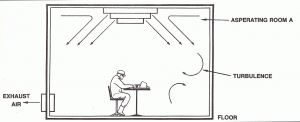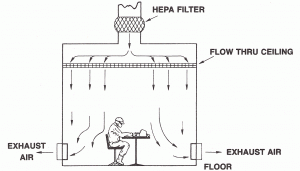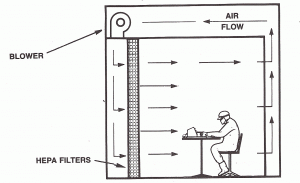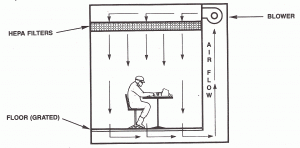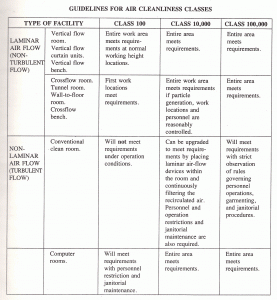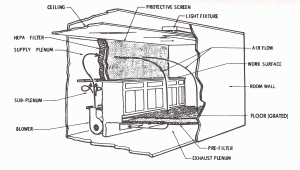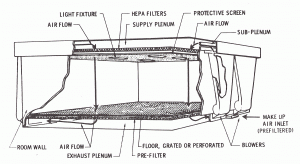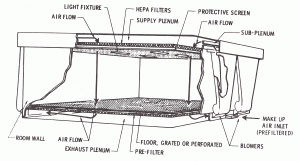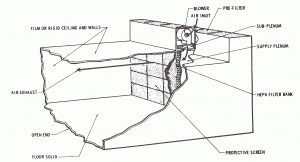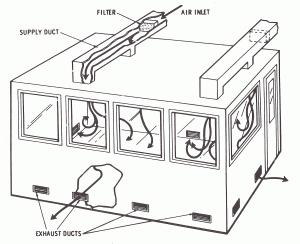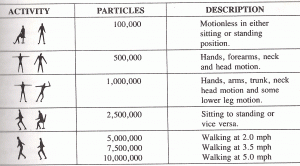Liberty Industries GUIDE FOR A CLEAN ROOM
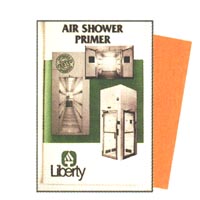
Liberty Industries has been in the contamination control industry a LONG time, and they have MANY resources available at a range of prices to make sure your laboratory or specialized manufacturing area is “top drawer.” Some of these materials would be good to give to ALL personnel who are involved and, of course, especially all managers responsible for proper cleanroom cleaning procedures, regardless of your cleanroom classification.
So, as just one of the many cleanroom supplies you and your staff utilize, consider the following, described in greater detail at Liberty’s website, www.liberty-ind.com:
- #7525; “Your Guide to an Ultra Clean Film”
- #7338; “Cleanroom Primer”
- #7332; “Your Guide to a Cleanroom”
- #7333; “Design and Operation of a Cleanroom”, by Philip Austin
- #7471; “How to Save $1,000’s on your Cleanroom”
- #7430; “Air Shower Primer”
- #7363; “Static Electricity in the Electronics Industry”, by AQ Testone
- #7455; “Maintenance Primer”
- #7453; “Cleanroom Encyclopedia”
- #7478; “Primer Binder”, which includes six booklets, #7338, 7332, 7430, 7455, 7471 and 7525
- #7555; “VLO Primer”

Cleanroom terms and definitions
There is a WORLD of information in existence on everything from processes for cleanroom packaging to how to store and suit-up in cleanroom gowns to all the various steps to keep every square millimeter of your area within the required specs…which are many: ISO 3, ISO 5, ISO 7, ASHP, USP 797, SUP 797, Joint Association of Hospitals and NARD recommendations for risk level III sterile compounding, etc. However, here are just a few of the tips that may be of help:
- Air lock: buffer zone that’s attached to the clean room, having interlocking doors to separate the two environments. This keeps contamination out as people and equipment enter the room, as well as keeps the positive pressure in the cleanroom which is necessary for the purpose of keeping out particulate.
- Air shower: a walk-through chamber which is designed to blow off particulate from cleanroom personnel and their cleanroom garments by way of high-velocity air nozzles, prior to their entering a controlled area.
- Clean room: also called a cleanroom, controlled, enclosed area, or white room. A specialized, enclosed area that utilizes environmental control methods regarding temperature, humidity, atmospheric contamination and pressure.
- Cleanroom garments: Garments that are lint-free are needed for a clean room, and are typically made from synthetic fabrics such as Nylon, Tyvek®, Dacron® and the like. These are critical in order to limit the entrance of contamination into the controlled area, especially from the greatest source of particulation–the human! In addition to skin cells, hair, and dandruff, high quality clean room garments minimize lint and other particulates personnel introduce. As a result, ALL people involved with contamination control, including those who are not regular personnel, MUST be required to wear cleanroom attire.
- HEPA filters: The word “HEPA” is an acronym standing for a High Efficiency Particulate Aire filter. These specially-made filters are able to capture particles which are .3µm (0.3 microns) or greater at an efficiency of no less than 99.97% or even 99.99%.
- Laminar flow: Refers to air that flows unidirectionally in a parallel plane.
- Micron: This is a unit of measure equal to 0.00003937 inch, which is 1 millionth of a meter.
- Particle size: This is the maximum dimension of a particle, and is measured by its diameter for a spherical particle, or linearly for a fibrous particle.
- Pass-thru window, (sometimes called a pass-through window, pass-thru chamber, or pass-through chamber). This is a cube-shaped box which has 2 interlocking doors and is used allow cleanroom personnel to pass materials in or out the primary area. By doing so, the positive pressure of the room is maintained and traffic is limited.
- Shoe cleaner: A device located in a gowning room or at the entrance to a cleanroom to remove footborne particulate from the shoe covers, shoes or boots of personnel. The unit is semi-automated or fully automated, and has four or five brushes on the top, sides and bottom, as a well as high-quality, filtered vacuum system (e.g. a HEPA filter) and collection pan.
- Tacky Mats®: Generically called adhesive mats, cleanroom mats, peel-off mats, tack mats, stick mats or sticky mats, Liberty’s trademarked Tacky Mat® is an important clean room barrier for footborne particulate, (e.g. dirt, dust, and, to a more limited degree germs such as bacteria, virus, and fungus microbes). Manufactured by Liberty since the early 1960’s, their famous mats are multiple layers of specially-treated film with either strips of dual-sided tape or a full-width adhesive on the bottom to anchor the mat to the cleanroom floor, typically at its entrance and usually used in conjunction with a shoe cleaning machine.
- ULPA filters: The word “ULPA” is an acronym for an Ultra Low Particulate Air filter. Like HEPA filters, ULPA filters are capable of removing particulate of .12µm (0.12 microns) or greater at an efficiency rate (measured by a laser scanner) of no less than 99.9999%.
- Uni-directional flow bench. Sometimes called a workstation, a work bench of this sort has its own air supply which is filtered. These units are typically described as a horizontal flow workstation or vertical flow workstation depending on the direction of the air over the work area. The air velocity (which ranges from 72-108 FPM (feet per minute) and make an ultra-clean work space for specialized processes.
TYPES OF CLEAN ROOMS
Type 1. The Conventional Cleanroom
A “conventional” room is enclosed, has incoming air that is both conditioned and filtered to create a positive pressure within the room. This air comes in via ceiling diffusers and exhausts through the wall-mounted registers which is the air return to the A/C system. Under the specs of Federal Standard 209C, this room could produce a Class 100,000 environment, assuming personnel entering it maintain proper cleanroom attire, appropriate contamination control equipment is utilized, and there is a regular maintenance and cleaning procedure done to eliminate contamination which enters or is produced inside the cleanroom.
Type 2. The Semi-Laminar Flow Cleanroom
This type of enclosed, clean area also has air that is both conditioned and filtered, where the air comes in via a ceiling plenum. At that point, the air is diffused throughout the room by way of many “slots” in the flow-thru ceiling tiles. Then the air is pushed vertically at low velocities, and exhausts near or at the level of the floor. As with the conventional cleanroom, this style is able to make a Class 100,000 atmosphere to the specifications of Federal Standard 209C, and it also requires rigid personnel control, high-quality, specialized equipment, and a cleaning routine consistent with maintaining that level of cleanliness.
Type 3. Horizontal Uni-directional Flow Cleanroom
This kind of enclosed, controlled environment has the treated air enter through a HEPA filter wall. The horizontal air velocity is 72-108 feet per minute (FPM) and it’s exhausted through an air return on the opposite wall. The design works for several class cleanrooms per Federal Standard 209C: Class 1, 10 or 100, with regard to the air “upstream” from the work area as, naturally, the air downstram depends on how contaminating the workstation is, though should exit via the return air wall. Finally, this room, as with all others, must be subject to rigid cleanroom techniques of the personnel, as well as a routine, diligent cleaning program.
Type 4. Vertical Uni-directional Flow Cleanroom
This enclosed cleanroom design has the conditioned air enter by way of a HEPA filter ceiling. The filtered air moves straight downward at 72-108FPM as the design above, but the air is then exhausted via a grate system in the floor. Further, like the prior unit, it, too, can produce a Class 1, 10 or 100 atmosphere per Federal Standard 209C upstream from the work bench.
THIS design is generally thought to be the one to use for “the optimum clean room” but requires VERY stringent cleaning techniques, done continually as part of the operating process, in addition to specialized cleaning performed for each area in the cleanroom.
GUIDELINES FOR AIR CLEANLINESS CLASSES
Particle numbers by class:
Max. no. of particles/ft³ > 0.5µ and larger Class Max. no. of particles/ft³ > 5.0µ and larger
- 10 & 100 10 & 100 0
- 1,000 1,000 7
- 10,000 10,000 65
- 20,000 20,000 130
- 100,000 100,000 700
- 1,000,000 1,000,000 6,500
Below is a helpful chart from Liberty regarding the appropriateness of which class cleanroom to what kind of air flow, in light of the material presented above.
AIRFLOW METHODS IN A CLEAN ROOM
THINGS TO REMEMBER REGARDING A CLEANROOM
In certain industries, performance is COMPROMISED when certain types of particulate is in the work environment. Examples are:
- Electronic, aircraft, missile and other specialized equipment does not perform properly or can fail over the long run.
- In industrial work areas, university laboratories, or hospital research facilities, processes can have their effectiveness highly-compromised or limited by chemicals and other materials with contamination–submicron-sized particles which are unwanted in the operation, sometimes caused by less-than-ideal environmental stability.
Many procedures have microminiature devices which are often found to be at risk with impurities such as dust, dirt, lint, skin cells, etc. of about .3 microns, as well as with the occurrence of temperature, humidity, static, etc. fluctuations. As a result, the cleanroom has evolved for both environmental and contamination control.
Your CLEAN ROOM, therefore, is an important factor to your facility regarding economic:
- manufacturing
- assembly
- cleaning and cleanliness
- preservation
- inspection, and
- measurement precision
This can also include a dust-free enclosure, environmental chamber for testing (e.g. temperature, humidity, altitude, vibration, stability, etc.), specialty workstations, laminar flow tunnels, workstations, hoods, air showers, and the like. In all of those, rigid control is needed for optimal results. Therefore, technicians in anything considered a white room must be specially trained to regularly perform the right processes and in the right order.
Major sources for complications are:
- Particulation/contamination created by the technicians themselves.
- Particulation/contamination caused by the work done in the cleanroom.
According to the Austin Contamination Index (Encyclopedia of Clean Rooms, Bio-Cleanrooms and Aseptic Areas), here’s what the typical tech generates in a room, even when fully-clothed and in appropriate cleanroom garments:
- Activity: sitting or standing with no movement. 100,000 particles/minute. (≥.3 microns)
- Activity: sitting or standing but with minimal head, forearm and hand movement. 1/2 million particles/min. (≥.3 microns)
- Activity: sitting or standing with average arm and body motion; 1 million particles/min. (≥.3 microns)
- Activity: changing positions, such as going from sitting to standing. 2.5 million particles/min. (≥.3 microns)
- Activity: (a) slow-speed walking e.g. 2 miles/hour. 5 million particles/min. (≥.3 microns); (b) average-speed walking e.g. 3.57 miles/hour. 7 1/2 million particles/min. (≥.3 microns); (c) fast-speed walking e.g. 5 miles/hour. 10 million particles/min. (≥.3 microns)
- Activity: climbing stairs. 10 million particles/min. (≥.3 microns)
- Activity: calisthenics. 15-30 million particles/min. (≥.3 microns)
10 RECOMMENDED INSTRUCTIONS FOR CLEANROOM EMPLOYEES
To get the maximum performance from your cleanroom, the following should be considered a framework of parameters to obtain the specs YOUR process requires:
- Because a “white room” is such a specialized facility, it demands restrictive access. Only certain people can enter and then only if they follow certain procedures. As a result, it’s best if visitors are approved by the cleanroom facility manager.
- The sole in/out to the room is by way of the air shower that provides an air lock to seal the positive pressure, internal air from the external environment.
- It must be mandatory that EVERYONE entering gown-up in the appropriate cleanroom garments, including (as needed) shoe or boot covers, a frock, lab coat or coverall (a.k.a. “bunny suit”), gloves, mask, beard guard or moustache cover, bouffant cap, protective glasses, etc. Further, because certain items are considered “contaminated” once the employee leaves the cleanroom, they must be discarded, e.g. lunch breaks, shift end, and the like.
- There must be no smoking or eating anywhere in ANY part of the controlled area.
- All PERSONAL items must be left in the employee’s locker in the ante-room, including tool boxes. Furthermore, employees must refrain from wearing linting/particulating clothing even if it is worn under cleanroom clothing.
- Only CLEANROOM paper products are allowed in the room, with the exception of materials properly sealed in plastic containers (such as technical manuals, reference books, notepads, and so forth.)
- No pencils (expecially with erasers) are to be used in the room; only ballpoint pens.
- Any procedure in the room that generates contaminants, such as sawing or grinding, and the use of sandpaper, abrasives, emery cloth, etc. must be disallowed unless there is an acceptable exhaust system. Lastly, no corrosive or flaking materials can be used in a cleanroom.
- Because a person is often the most contaminating component of a cleanroom, all personnel who have unusual skin problems, a rash or sunburn, etc. must put on a recommended, lanolin-based skin lotion, and no cosmetics are ever to be worn. Workers with dandruff should wash their hair a minimum of weekly and use an appropriate shampoo that controls the problem. They must be clean-shaven, with hair of reasonable length, and clean hands and fingernails. Finally, if a person has an ailment, such as a cold, they would cause problems with their coughing, wheezing and sneezing, so should be directed to work in a non-controlled area.
- All equipment, parts, containers, materials, and so on must be cleaned thoroughly prior to being introduced to the room. Trash containers are to be the enclosed kind, and both emptied and vacuumed daily. Cleaning procedures are a totally separate issue and are handled separately in this guide.
THE IMPORTANCE OF CLEANROOM GARMENTS
One of the most particulating factor in a controlled environment is the PERSON–their clothing, shoes, hair, skin, etc.–which emphasizes the need for stable, high-quality, specialized garments to achieve the cleanroom level your room requires. Appropriate “wearability” means that the garment resists breakdown and emits little to no particles, such as lint.
Synthetic materials are ideal for a clean environment because:
- Synthetics are woven into the fabric of frocks, lab coats, coveralls, shoe covers, bouffant caps, etc.
- Nylon™ is good in situations without static and acid. It is a material that allows a garment to be firm yet have the appearance of silk, is durable, and is resistant to staining (though not stain-proof). It’s easily washable and dries quickly because it only absorbs 4-5% moisture. With a quick pressing, the lab worker looks sharp and is ready for business!
- Dacron™ is even one step above. It’s comparatively more opaque than nylon, as it is notably different in nature. Dacron is polyester; nylon is a synthetic hydrophobic fiber. Dacron has a soft, fine feel, but exudes crispness, drapes smoothly, is a bright white when new and retains that whiteness well with proper washing. However, nylon tends to yellow over time.
- Wrinkled cleanroom uniforms can affect the image of the workers. Dacron is very wrinkle resistant, though excessive heat can cause permanent wrinkling. Furthermore, Dacron polyester will melt when it’s exposed to fire, rather than flame. If your cleanroom process involves acid, Dacron is the better choice, and it absorbs moisture less than nylon–with a moisture absorbance of only .2% to .8% moisture.
- ESD (electro-static discharge) creates another twist in specialized environments and demands a blended synthetic fabric in a cleanroom garment. One alternative for low ESD is the use of continuous-filament yarns woven in a combination of Rayon™ and Dacron™. Though this combo has a shorter life, rayon is a short fiber which doesn’t break loose from its weave (e.g. in high drying temperatures) and reduces static charge build-up because of its improved surface conductance.
- A compromise for electrostatic dissipative applications is Dacron cleanroom clothing, as they give both long wear and low static charge. Then, when anti-static agents are used to further treat the garments, the Dacron surface conductivity is increased to the level of cotton cleanroom garments. (See www.liberty-ind.com for extensive details about anti-static products, as well as our own website, www.rep.com. As always, when you have an interest in any item, contact Midstates Marketing so that you can find out now only the standard List Price and lead time, but also OUR discounted price you’ll get when you buy.)
- It is important that you know that COTTON garments are well-known for putting off notable quantities of lint/particulate. One aid to solving this problem is synthetic starching compounds, though starching is just an exterior coat on a fabric so, when the material is dry, much starch material sloughs off…in your cleanroom…which is NOT acceptable in any critical clean environment.
- For fabric strength, e.g. to minimize garment runs, consider garments with herringbone twill weaves. It is not surprising that this kind of desirable weave is very popular as part of a modern cleanroom design. In fact, taffeta is often chosen because it has an even tighter weave which better resists runs, and feels cooler and lighter to the user.
- Cleanroom garment cleaning typically becomes necessary mostly due to contamination by the worker’s everyday clothes under the garment. The more active the worker in handling their cleanroom responsibilities, the sooner the garment needs cleaning because particulate passes through it and both clings to it and falls away. That particulate then contaminates equipment the garment touches as well as the cleanroom flooring. This emission effect of the cleanroom clothing affects the overall contamination level in any white room, so garment change and rotation should be required 2-3 times per week on average.
CLEANROOM GARMENT DESIGN
When choosing a quality source of clothing for lab techs to wear, here are some decision parameters regarding synthetic, low-linting or lint-free fabrics:
- Does the garment have a minimum of seams and firmly envelop the material’s edging?
- Is the garment loose-fitting in order to minimize abrasion with street clothes underneath?
- Does the garment have NO pockets, flaps, belts, tucked or pleated areas?
- Is the garment made with the strongest filament fabrics available to minimize breakdown?
- Does the garment have a tight weave to prevent internal dust and lint from passing through?
- Is the garment non-static generating, yet also non-linting?
- Are the sewing threads made of mono-filament materials that is lint-resisting?
- Does the garment securely cover as much of the worker as possible, e.g. around the neck as well as the wrists and ankles which are known sources for particulate emission?
TYPES OF GARMENTS USED IN A CLEANROOM
1. FROCKS, LAB COATS AND COVERALLS. Whether you decide on a lab coat or coverall that’s disposable, or washable and re-usable, be sure to choose a simple design that’s especially snug-fitting at the neck. Collars, pockets, darts, belts, pleats, and the like both retain and generate lint. Also, elastic around openings is key to a close fit. For the ultimate in cleanroom cleanliness, a coverall (sometimes called an overall or “bunny suit”) should be selected. The coverall’s hood needs to be INSIDE the coverall so that particulate (e.g. hair, skin cells, and lint) falls into the coverall. Furthermore, the legs should be tucked into the cleanroom boots, boot covers or shoe covers so that all particulate is captured and doesn’t get out to contaminate the cleanroom.
A frock is sometimes permitted in certain cleanrooms, but be aware that the downside of a frock is that the bottom is open which enables materials to fall to the floor. As a result, with the various activities by cleanroom personnel, that particulate is easily swirled up in air movement into the clean environment.
2. BOUFFANT CAPS AND HOODS. An important part of a critically clean environment, contamination control from the head must be addressed. A hood covers the head, neck, and ears and is tucked into the lab coat, frock, or coverall to catch “slough” from escaping. They fit snugly to cover all but the face (sometimes the eyebrows), utilizing elastic, snaps, and various sizes to fit well.
Some applications are suitable to using bouffant caps, which are typically made of cellulose, polypro, polyolefin, and Tyvek™ and are intended to limit particulating from head hair. Having similar limitations as a surgeon’s cap, they can cover the ears to some degree but note that gaps can allow dandruff, and other particles to fall to cleanroom work surfaces and floor.
3. FACE SHIELDS, MASKS, BEARD GUARDS, MOUSTACHE COVERS, ETC. Just as with other cleanroom garments, these items may also be necessary for your procedures. Certain lab operations require such materials around your laminar flow workstations–vertical flow, horizontal flow or cross flow, vertical fume hoods, biohoods, air curtains, and other cleanroom equipment. The same concepts apply: eliminate and contain any and all particulates.
4. FOOT COVERINGS. Because technical lab personnel may walk from a dirty parking lot with rain, mud or snow, then perhaps through a dusty manufacturing area…into your cleanroom’s gowning area. Though they may use a shoe cleaning machine, no shoe cleaner can remove all contamination and no shoe bootie can completely capture dirt, dust or lint. As a result, your controlled area will degrade from a clean, ambient atmosphere to one battling contamination. This is why management of foot-borne particles is critical to maintaining your required cleanroom standards.
5. GLOVES AND HAND CARE. Hands introduce many complications to critical area, e.g. perspiration and skin oils, skin lotions, hair spray, fingernail polish and other cosmetics. Because technical workers have constant contact with your operation’s products, tools and equipment, the cleanroom facilities managers must not only establish and maintain strict procedures, they must choose gloves appropriate to the laboratory scenarios. Non-porous gloves become uncomfortable fairly quickly, yet perspiration can bleed through fabric, as well as through garment seams. Rubber gloves contain free sulphur and can cause chemical contamination. Be aware of such considerations when selecting the hand coverings for your personnel.
6. WIPES. Sometimes referred to as wipers, wiping cloths come in a wide variety of shapes, sizes and materials. The problem is: the more non-particulating the wipe, the less its ability to absorb or pick up liquids and particulate! They can actually SPREAD oil, grease, etc. rather than collect them. So, talk in detail with your representative at Midstates Marketing for help in determining what’s best for your operation.
USE OF A CLEANROOM LAUNDRY
Reusable garments, sometimes called washable garments, can be a cost saver as compared to disposable garments, depending on the usage of the clean room. Just as a baby diaper service leaves a new supply when picking up the items needing laundering, a cleanroom laundry can provide that same convenience, whether it’s internal or external to your facility. However, a specialty laundry does not just offer garments that are free from dirt and spots, they give your contamination control staff clean, ready-to-wear cleanroom garments that are free of lint, dust and other particles, and all other types of contamination.
Laundry services giving “super clean” garments:
- Offer the right garments.
- Control the entire process of picking up the soiled garments and delivering the clean supply.
- Properly wash and dry the garments using the correct methods.
Garment handling:
Naturally garments used in a laboratory or specialized-function white room must be kept separately from regular, manufacturing uniform laundry. Items needed for this procedure are:
- Heavy plastic bags
- Dacron™ or nylon garments
- Nylon-lined carts or tote boxes made of stainless steel
All materials are to be kept clean continuously, but especially in dealing with the washed and dried garments. The staff handling them must wear cleanroom garments THEMSELVES and use all the techniques of a standard cleanroom during the washing, drying, folding, packaging, etc. operations.
Washing and drying:
It is important to have a clear idea the level of cleanliness you need your garments to be, in regard to the class of your cleanroom. Logically, the higher the degree of quality your garments must be, the more stringent the techniques that will have to be utilized in your laundering methods and, therefore, the more the process cost will be per garment.
There needs to be a separate set of machines for synthetic garments. Once washed, the garment goes from the washer to a dryer with controlled, clean, and filtered air. The dried garments are then packed in a sealed bag–all within the laundry’s controlled environment. At that point the garments are ready for delivery to the user or customer.
Because any cleanroom garment is intended to protect the product or process from the personnel involved, these laundry precautions are needed by any cleanroom garment manufacturer:
- Carefully inspect and repair any and all flaws of the garment before it is washed.
- Zip all zippers up.
- The smaller the load, the less the mechanical action.
- A neutral or mild, alkaline detergent or soap should be used.
- If at all possible, don’t use bleach, but if it is needed, have it be a lower concentration.
- The washing temperature should be no more than about 140°F.
- In order to reduce wrinkles from setting in, quickly put the garments directly onto plastic hangers (not metal). Avoid extraction or tumbling.
- Though ironing should not be needed, if it is done, use as low a temperature as possible.
- If at all possible, don’t use anti-stats*. Note that static is generated in dryers that are over-heated, so a temperature of 120ºF is a good rule-of-thumb.
*An “anti-stat” surface agent is a static-eliminating chemical that is put into the last rinse cycle water so that it sticks to the garment surface when dried. Because it absorbs moisture from the air, the static is reduced, BUT if too much is added, anti-stat flakes will particulate from the garments into the cleanroom.
Packaging:
The phrase “cleaned and packaged in a cleanroom” used by launderable garment manufacturers refers to several factors:
- the medium in which the garment is packaged
- the controlled environment where the packaging was done
- the cleanliness of the work surfaces used during the packaging process
However, having a quality cleanroom garment cleaned, dried and handled in the proper cleanroom process, packaged in the correct packaging for the appropriate class of cleanroom will be of little value if the cleanroom personnel do not dress appropriately for the cleanroom! Each lab technician must treat the garment correctly–wear their cleanroom garment properly secure it at the neck, down the front, and at the wrist and ankles. If the garment is not worn correctly, contamination pours out of the exposed area into the cleanroom. As a result, testing of the cleanroom (e.g. with a particle counter) will show that that worker is causing the general room contamination level to go up.
ENTRY PROCEDURE FOR YOUR CLEANROOM PERSONNEL
- Require that everyone coming into your cleanroom must clean their shoes or boots in an automatic shoe cleaner, such as those shown in the shoe cleaner portion of Midstates Marketing’s or Liberty’s website.
- People should wash their hands and face, if necessary. Drying should not be with paper towels which particulate, but with either lintless wipers or a hot air hand dryer.
- Have everyone leave personal items from their street clothes in their car or put them in a storage locker, e.g. in the gowning room. If something’s of such importance that is not tolerable, those items can be kept on them, but not exposed to the environment of the cleanroom.
- When all personnel “gowns up” they must be cautious to not contaminate their garment by touching it to the floor or to their shoes. They should check their garment for a frayed collar or cuff and, if it has a problem, they should not wear it. Buttons, snaps or their zipper must be fastened fully. Their head and hair should be covered with a hat or snood, their bear and/or moustache should be covered with a moustache cover, beard guard or face mask, their work boots or shoes must be covered with boot or shoe covers, and their hands should have gloves.
- Everyone entering the clean room must go through an air shower by standing straight up, with hands and arms about 8 inches from their sides, and with their feet somewhat spread. They must then rotate all the way around 360° allowing the air jets of the air shower to blow off or “wash” all exposed skin as well as the surface of all of their garments.
HOW TO CLEAN A CLEANROOM
(as adapted from writings by John J. Nappi, Jr. of Liberty Industries; East Berlin, CT)
- Make sure that all products purchased for your cleanroom for cleaning and maintenance are OK’d by your Facilities Manager’s sourcing coordinator who should be working closely with the Materials Laboratory who investigates and approves them as meeting the requirements of your cleanroom.
- Having the rule that it is prohibited to introduce line and volatile agents is critical, because many common cleaning agents have ammonia and/or pine oil. The fumes from those can form gummy residue, as well as react with oils, grease or even attack brass alloys (e.g. certain gear assemblies or bearing separators).
- Since Armstrong vinyl floor coverings like Corolon™ (Terrazo™, Montina™) are often used in cleanrooms, it’s good to listen to the experts. They recommend using the “triad” floor product line Liberty offers which includes SuperGard® sealer by applying it “straight” in light coats with a chamois skin mop, 1 quart/6-700 ft². (See also Superscope II® floor sealer and De-Fense® urethane-fortified floor emulsion, seal and finish.)
- After putting down the sealer, a daily, damp, dry mop is needed to give the floor covering a long life. Liberty’s MIL-D-1679E type 1, non-residue, clean liquid detergent is a non-ionic surface additive AGENT but it doesn’t have any soaps, builders or additives. Added to water (.5% by volume maximum), it’s used to scrub benches and decks followed by a clear water rinse. Then, when a part of the cleanroom becomes worn (e.g. the entrance), it can be touched-up by a thorough cleaning, followed by applying TWO light coats rather than a heavy one, allowing the area to dry in-between.
- At some point, the entire room will become work and need to be re-done, so the SuperGard® cleaner and stripper can be removed using Liberty’s Superscope II®–1 part SuperScope to 5 parts water–and a mop. (No scrub machine is required.)
- Ceiling panels are typically made from bonderized aluminum (because it’s rated a self- extinguishing material) and, because their cellular panel design tends to minimize the collection of dust, an annual cleaning should be adequate. In order to retain the feature of the panels to have less dust attraction due to their being destaticized when manufactured, the protective coating should be washed in this way:
- Take off the hold-down clips and remove the panels from the suspension system.
- Mix up Liberty’s general purpose GP Cleaner in a solution of 10% detergent in 90% clean, warm (100°F+) water. (NOTE: change the liquid often as it becomes dirty.)
- Put the ceiling panels down into the solution and swish them around. Then carefully use either a sponge or soft brush on the areas which are notably dirty.
- Remove the panels and let them air dry. DO NOT WIPE or force dry or you’ll remove that destaticized coating.
- ONLY chamois skin or polyurethane mops, polyurethane sponges, and either rubber squeegees (or elastomeric synthetics should be used for wet cleaning a large part of a cleanroom. (NOTE: when cleaning materials begin to deteriorate and particulate, e.g. worn sponges, replace them.)
- In the event of a serious oil spillage requiring heavy-duty swabbing, here’s an example where you can mix various Liberty cleaners to get a workable combination: (a) In an appropriate mixing container, add 1/2 oz. MIL-D-1679E and 1 oz. isopropyl alcohol, (c) cap and shake to mix well, (d) put about 1 gallon of clean water in a mop bucket, (e) pour the non-ionic-alcohol mixture into the bucket…and rinse out the mixing container. (Note: for a stronger solution, increase the amount of MIL-D-1679E, and for larger amounts use an appropriate ratio increased volume.)
- Other cleaning products include: distilled water, non-residue-forming detergent, cleanroom glass and plastic cleaner, lint-free wipes, non-flaking/high-grade plastic buckets, cellulose sponges and sponge mops (with aluminum handles), Tacky Roll Mops™, fiberglass ladders, a central vacuum system or a portable unit if the exhaust has absolute (HEPA/ULPA) filters.
- Any cleanroom maintenance personnel must adhere to standard cleanroom regulations, e.g. proper dress and cleanliness methods.
- Cleanroom workers are to daily maintain their work areas, including workbench tops, tables, chairs, etc. and their tools as necessary.
- Before each work shift the clean room floor should be damp mopped with distilled water and then vacuumed dry. Each week the floors should be damp mopped with distilled water and detergent, and then vacuumed dry. (Note: floors should not be waxed.)
- Every days the cleanroom walls should be vacuumed, and weekly they are to be wiped with a damp sponge using distilled water, then vacuumed dry. This holds true also to remove any visible dirt or other deposits.
- Windows should weekly be washed both inside and out, and wiped dry with a lint-free wipe.
- Ceilings should be vacuumed daily, and weekly should be wiped with a damp sponge using distilled water, then vacuumed dry. When there is visible dirt on the ceiling, it should be washed with detergent and distilled water, then vacuumed dry.
- Overhead lights (e.g. troffers) should be vacuumed often to remove accumulated dust, and their lenses should weekly be wiped with a damp sponge using distilled water, then vacuumed dry.
- The normal work shift can be used for all DAILY cleaning except for the floors, possibly by someone on the cleanroom staff. WEEKLY cleaning should be done when the room is not being used, e.g. after hours by the custodial service crew.
- The cleanroom facility supervisor can evaluate the traffic on the entranceway Tacky Mats™ and decide how often to tear off the top sheet, e.g. once a day prior to the main shift, or twice a day with the second replacement occurring at lunch time, or if there are multiple shifts, at the beginning of each shift.
MONITORING CLEANROOM CONTAMINATION
The working specifications of your cleanroom facility will determine what regular schedule and how stringent a procedure to monitor the airborne contamination. Military specs, for example, call for CONSTANT monitoring while others may require monthly, quarterly or annually. The more the room is monitored, the better the record of contamination control, so cleanroom class will probably be a major factor. Industry governing requirements often state that the cleanroom atmosphere be monitored in an ambient, unoccupied state to use as for baseline data and/or, for a reading of an operational contamination level, while the room is occupied and working.
Airborne contamination is typically monitored in one of two ways:
- An air sample collecting particles (e.g. ≥ 5 microns) on a membrane filter are microscopically counted. (See technical information on such methods in the Federal Standard data below.)
- Particles suspended in an aerosol via a Light Scattering Device can be automatically counted, e.g. for particles ≥ .12 microns. (Added note: see product information regarding PARTICLE COUNTERS within www.rep.com or at Liberty’s website, www.liberty-ind.com).
FEDERAL STANDARD 209 CONTROLLED ENVIRONMENT/CLEAN ROOM AND WORK STATION REQUIREMENTS. (For latest information, see: www.iest.org)
As a public service, listed below are some terms and definitions of common components of a cleanroom, quoted from Liberty Industries’ “Your Guide to a Clean Room Facility”. Because this periodically is updated and changes, we recommend getting the most up-to-date version from the Institute of Environmental Sciences and Technology or another credible source.
- Airborne particulate cleanliness class. The statistically allowable number of particles equal to or larger than 0.5 micrometer in size per cubic foot of air.
- Calibration. Comparison of a measurement standard of instrument of unknown accuracy with another standard or instrument of known accuracy to detect, correlate, report, or eliminate by adjustment any variation in the accuracy of the unknown standard of instrument.
- Clean zone. A defined space in which the concentration of airborne particles is controlled to specified limits.
- Clean room or cleanroom. A room which the concentration of airborne particles is controlled to specified limits.
- As-built cleanroom (facility). A cleanroom (facility) that is complete and ready for operation, with all services connected and functional, but without production equipment or personnel within the facility.
- At-rest cleanroom (facility). A cleanroom (facility) that is complete and has the production equipment installed and operating, but without personnel within the facility.
- Operational cleanroom (facility). A cleanroom (facility) in normal operation with all services functioning and with production equipment and personnel present and performing their normal work functions in the facility.
- Unidirectional airflow. (Commonly known as laminar flow). Air flowing in a single pass in a single direction through a cleanroom or clean zone with generally parallel streamlines.
- Nonunidirectional airflow. (Commonly known as turbulent flow). Airflow which does not meet the definition of unidirectional airflow by having either multiple pass circulating characteristics or a nonparallel flow direction.
- Condensation nucleus counter. An instrument for counting small airborne particles, approximately 0.01 micrometer and larger, by optically detecting droplets formed by condensation of a vapor upon the small particles.
- Optical particle counter. A light-scattering instrument with display with display and/or recording means to count and size discrete particles in air.
- Particle. A solid or liquid object generally between 0.001 and 1000 micrometers in size.
- Particle size. The apparent maximum linear dimension of the particle in the plane or observation as observed with an optical microscope, or the equivalent diameter of a particle detected by automatic instrumentation. The equivalent diameter is the diameter of a reference sphere having known properties and producing the same response in the sensing instrument as the particle being measured.
- Particle concentration. The number of individual particles per unit volume of air (particles per cubic foot or particles per liter.)
- Student’s t distribution. The distribution: t=(population mean minus sample mean)/standard error) obtained from sampling a Gaussian (“normal”) distribution. (Available in tables in statistics texts).
- Upper confidence limit (UCL). An upper limit of the estimate of the mean, calculated in such a way that in a given percentage of cases (here, 95%) the upper limit of the estimate would be more than the true mean, if the means were sampled from a Gaussian (“normal”) distribution.
Note: Much more information will be added to this page, including how to do contamination monitoring and verification, and more. Continue to check back periodically at www.rep.com for updates and added material.

